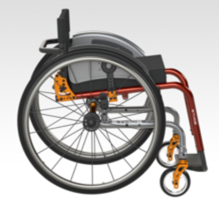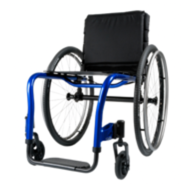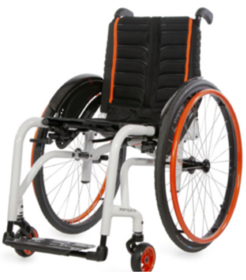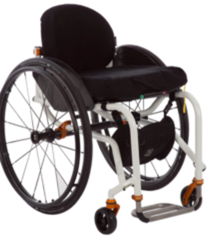What We Will Be Covering
- What is an ultralight manual wheelchair?
- Clinical Guidelines
- Configuration
- Propulsion techniques
- Case Study
Thank you to everyone for taking the time to attend this course. I do hope that it is helpful to you as well as helpful to the clients whom you serve. Today, we are going to be talking about wheelchair mobility, specifically ultralight wheelchairs. This is one type of manual wheelchair.

Figure 1. Ki Mobility Ethos.
We are going to get into some details about how these can be configured and how we can best instruct users on how to propel them in order to increase efficiency and decrease their risk of injury and pain. This is what we are going to be covering in this particular course. We are going to define an ultralight manual wheelchair in the context of other wheelchair frame options. We are then going to discuss clinical guidelines for the use of ultralight manual wheelchairs. And, for whom are these appropriate? How are they configured to best meet an individual's needs? What are our most efficient and optimal propulsion techniques? Finally, we will finish up with a detailed case study.
SMS Series
- This is part of a series of webinars designed to prepare the participant for the Seating and Mobility Specialist examination.
- And… develop more advanced seating and wheeled mobility skills
This particular course here is part of a series of webinars and is designed to prepare you for the Seating and Mobility Specialist examination. This is a certification that is available through the Rehabilitation Engineering and Assistive Technology Society of North America or RESNA. They have two certifications, the ATP, or assistive technology professional, as well as the SMS. Whether or not this is a certification that you are interested in, I certainly hope that this series will help you to develop more advanced seating and mobility skills.
Manual Wheelchairs
- A manual wheelchair is designed to provide dependent or independent mobility to a client, as well as support an appropriate seating system.
Let's talk for a minute about manual wheelchairs. A manual wheelchair as opposed to a power wheelchair is generally lighter and designed for self-propulsion, though some of these are better designed for self-propulsion than others. For instance, there are manual wheelchairs used for those that have dependent mobility and requires a caregiver to push. A manual wheelchair is designed to provide either dependent or independent mobility to a client, as well as support in an appropriate seating system. These chairs can support quite a wide variety of seating systems and a variety of sizes.
Assessment
- Assessment is typically done with a wheelchair supplier.
- Lightweight, Ultra Lightweight, and Pediatric manual wheelchairs are considered Complex Rehab equipment.
- Complex Rehab is typically recommended by a professional who is certified:
- ATP: Assistive Technology Professional
- SMS: Seating and Mobility Specialist
- These are obtained through RESNA
- Rehab Engineering and Assistive Technology Society of North America
When assessing a client for a manual wheelchair, this is typically done with a wheelchair supplier. The supplier is somebody who participates in the evaluation and is very familiar with equipment options. They will submit all the necessary paperwork to achieve funding approval for the recommended equipment. Once the funding is secured, the equipment is ordered and then fitted to the client. During this entire process, the supplier is a very critical player.
Lightweight, ultra lightweight and pediatric manual chairs are under the umbrella of complex rehab equipment. Complex rehab equipment is typically recommended by a professional who is certified. The supplier most likely will have a certification called the ATP, Assistive Technology Professional. Medicare, in particular, and some other funding sources require that if complex rehab is being recommended that the supplier has to have their ATP, or they are not allowed to participate in the process. Always keep in mind that if you are looking at a manual chair in one of these categories you need to be working with an ATP. While a clinician can have their ATP, the supplier still needs to have that ATP certification as well.
Considerations
When we are assessing someone to determine the optimal manual mobility base for them, there are a number of considerations that we need to keep in mind.
- Considerations include:
- Strength, range of motion, muscle tone and orthopedic status
- Cardiopulmonary status and fatigue
- Potential for change in function or size
- Positioning needs
- Environmental needs
We have to examine and assess the client's available strength, for example, for self-propulsion and even for transfers. Their range of motion, muscle tone, and orthopedic status are going to impact their required seating needs. And, depending on the seating system required, this could impact the wheelchair frame configuration. If this client has to sit at a particular angle at the hips, knees, or ankles, we may have to consider a very specific frame for that purpose.
We need to assess cardiopulmonary status and fatigue or try to get that information from the medical team. Part of our assessment when looking at a chair that could be self-propelled is whether this client is able to safely self-propel it. We may choose an ultralight manual wheelchair over say a lightweight manual chair in order to decrease the energy expenditure of the client.
We also need to keep in mind the potential for change in function or size. If this person has a progressive condition that can impact their future equipment needs, we have to keep that at mind. And if this is a person who is growing or gaining weight, we need to make sure that the chair can accommodate this.
We also need to look at positioning needs as this is going to determine the type of seating system that is going to be within the frame.
Lastly, there are environmental needs. Where is this person going to be using this manual wheelchair? Is it primarily indoors on level smooth surfaces? Does this family have thick carpeting in the house? Is the client going to be outdoors? Is it a rural area or are there mostly pristine sidewalks with built-in ramps at each corner?
Manual Wheelchair Types
These codes and terms are really driven by Medicare. This is not my favorite way of categorizing equipment, but funding is a big driver in these issues. Most people working in manual chairs do refer to these Medicare guidelines.
- Standard Wheelchair (K0001)
- Standard Hemi Wheelchair (K0002)
- Lightweight Wheelchair (K0003)
- Lightweight Wheelchair (K0004)
- Custom Lightweight and Ultra Lightweight Wheelchair (K0005)
- Pediatric
- Bariatric
- Specialty
We have a variety of manual wheelchair types. First, we have standard wheelchairs, K0001. These are not great wheelchairs for practical usage. They tend to be very heavy with very few frame adjustments. These are sometimes referred to as "fleet wheelchairs" and are the wheelchairs that are typically parked near hospital entrances. If somebody quickly needs a ride to and from their car into the doctor's office, you could use something like this. They are almost indestructible, but they are not going to provide the support that a client needs and are very difficult to push because of the configuration as well as the weight. This simply means that it can be lowered down. Sometimes, if a person has had a stroke and has hemiplegia on one side of their body, they may push with only one hand on their unaffected side and may supplement that pushing by using the foot on the unaffected side as well. For the feet to reach the floor for self-propulsion, we need a lower seat to floor height, and that is this hemi style wheelchair.
We then have two different categories of lightweight chairs. There are some subtle differences there that Medicare uses to discriminate those.
What we are going to talk about today is the custom lightweight and ultra lightweight wheelchairs, K5s. These weigh much less than the other chairs, even less than the lightweight, and have many configuration options that are designed to increase the efficiency of self-propulsion.
Other categories of manual wheelchairs include pediatric, bariatric, and various specialty manual wheelchairs. This, for example, may include a sports chair, like one designed for tennis.
Custom Lightweight & Ultra Lightweight
- Medicare K0005
- Weigh less than 30 pounds, as low as 17 to 18 pounds
- The greatest degree of options:
- Size
- Frame adjustments
- Suspension
- Casters
- Designed to maximize self-propulsion efficiency and reduce RSI risk
Even though this title includes custom lightweight, most people are going to think of a K5 as an ultralight chair. In this category of ultra lightweights are chairs that weigh less than 30 pounds.

Figure 2. Quickie QRi.
Some of these are as low as 17 to 18 pounds and are very lightweight. This is an advantage because the lighter the chair is the easier it is to propel. Perhaps, some of you like to ride bikes. I have a pretty cheap Huffy bike that I bought at Walmart. It was not very expensive, but it is clunky and pretty heavy. I had a chance to try my friend's very lightweight bike. What a big difference! If you have a clunky heavy base, it is much more difficult to propel. These are weighed in different fashions depending on the manufacturer so it is important that you read the specifications. It is not uncommon for a manufacturer to say our frame weighs 22 pounds, but when you read the fine print that might be without the rear wheels, the swing-away footrest hangers, or without seating. It is important that we compare apples to apples. If one manufacturer lists the weight of their chair with rear wheels and another without, we need to keep in mind that when we are comparing products. You can ask the manufacturer the total weight to make a comparison is there are similar components mounted.
Ultralights also have many options available on them, more than the other manual wheelchair categories. These are available in a wide range of sizes from very, small pediatric ultralight chairs through an ultralight that can accommodate a very tall adult. There are also many frame adjustments available. These frame adjustments are important for a number of reasons that we will go into more detail within this course. They include things like accommodating the seated angles of the client, accommodating a certain amount of growth, increasing the center of gravity and stability of the chair, and optimizing self-propulsion.
Many of these ultralight chairs also include suspension. This is important because as you are self-propelling a manual chair there is a certain amount of vibration that comes through the frame. Depending on the terrain, there can be jars and jolts throughout that ride. These vibrations can be translated through the frame to the client's body. This can lead to fatigue and pain, and perhaps, limit this person's ability to use the chair throughout the day. As a result, the suspension becomes very important.
There are also a variety of front caster sizes. In general, the smaller the caster the more maneuverable the chair. But, the smaller the caster the more difficult it is to use if you are not on a smooth level surface. These small wheels can get caught even in a crack in the sidewalk. In general, these are designed completely around the fact that we are optimizing self-propulsion efficiency and reducing the risk of repetitive stress injuries.
Appropriate Clients
Who is appropriate for a custom lightweight or ultra lightweight chair? These are appropriate for any client who is self-propelling and using both of their arms for a significant time period as it is designed to minimize that risk of RSI and to optimize propulsion.
- Appropriate Client:
- Any client who is self-propelling using both arms for a significant time period
There a lot of folks out there who have propelled for decades and destroyed their shoulders, elbows, and wrists, and now have to use a power wheelchair as a result. We do not want that to happen. We need to do everything we can to minimize that risk.

Figure 3. Quickie Xenon.
Ultralights Vs. Standard Wheelchairs
- Improved push speeds
- Improved distance
- Decreased energy expenditure
Beekman, C. E., Miller-Porter, L., & Schoneberger, M. (1999). Energy cost of propulsion in standard and ultralight wheelchairs in people with spinal cord injuries. Physical therapy, 79(2), 146-158.
An ultralight manual chair versus a more standard wheelchair has improved push speeds. For every stroke against the wheel, the wheelchair goes further and faster. There is improved distance and pushed speeds as compared to a standard wheelchair. In addition to that, there is decreased energy expenditure. When pushing a standard chair, there is a certain amount of energy and you can only go a certain amount of distance and a certain speed. When I have an ultralight I go further, faster, and with less energy. Fortunately, we have quite a bit of research out there. This is an older study, but a very good one that shows that there has been a lot of research about ultralight wheelchair design.
Folding and Rigid Frame Options
- Folding is easy to transport and often has more growth or other frame options.
- Rigid frames are lighter, more durable and more energy-efficient.
When I am looking at options for a client in the ultralight category of manual chairs, these chairs tend to fall into two major categories, folding and rigid. Where when we look at other categories of chairs, like standard and most of the lightweight, these are only available in folding. Rigid frames are lighter than folding chairs because they do not require the additional hardware to allow this to fold. They tend to be more durable, less moving parts, and more energy-efficient. When the client is pushing a rigid frame, energy is not lost in the folding mechanism. Instead, it moves the chair only forward. But, a folding chair can be easier to transport and often has more growth or other frame options. It also is easier sometimes for certain types of transfers like a stand pivot transfer because those footplates swing out away, as opposed to a more rigid option.

Figure 4. Ti Lite TR.
Why do we have these rigid frames and what does that mean? A typical wheelchair that most people think about folds from side to side. We will see a picture of that in a moment. Instead, in a rigid chair, the back folds down, and the wheels can be removed.
Rigid Frames Efficiency
- Rigid frames are more efficient to propel
- Why?
- Fewer moving parts
- Energy is transferred into the ground instead of into a moving frame.
- Cross braces can twist and move when crossing uneven surfaces, resulting in energy loss.
Again, rigid frames are more efficient to propel than a folding one, which is why we find this design on many ultra lightweight chairs. Again, the main goal of an ultralight chair is to optimize efficiency. Why is it more efficient? There are fewer moving parts. Again, the energy used by the client against the wheelchair rims of the rear wheels is transferred into the ground to move the chair forward instead of into the moving parts of the frame.
